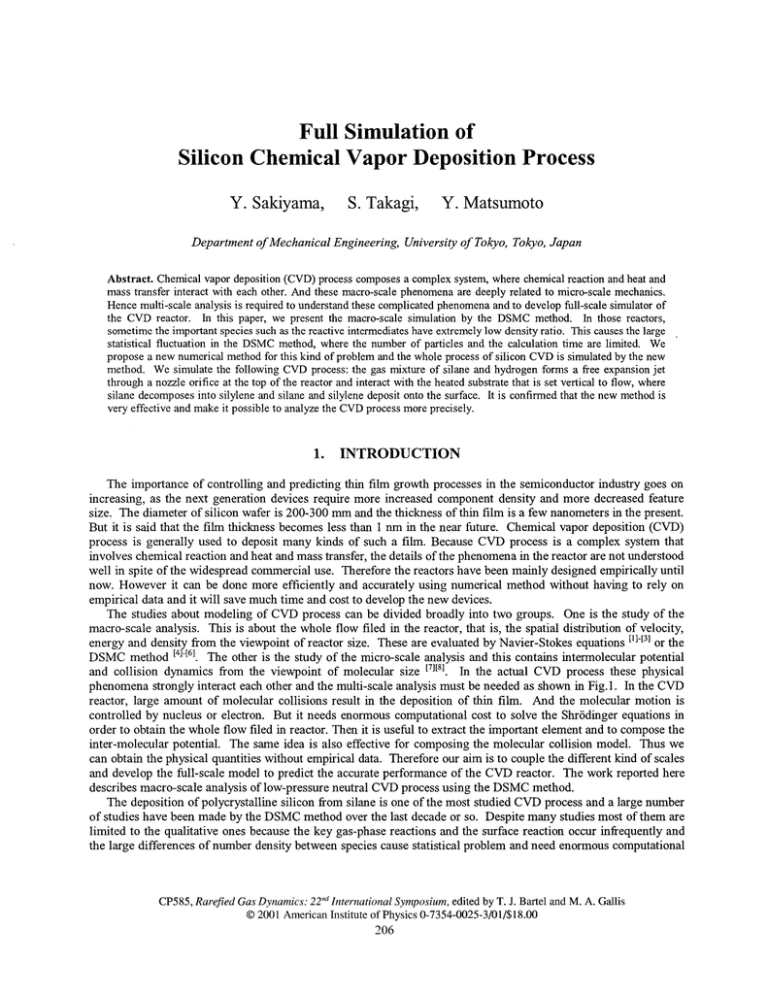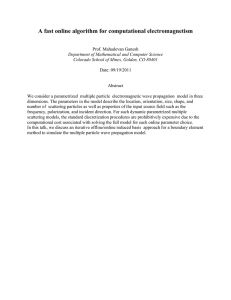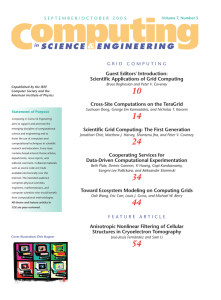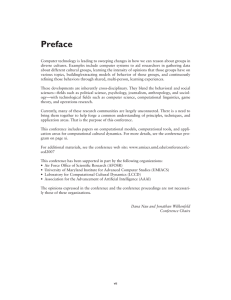Full Simulation of Silicon Chemical Vapor Deposition Process
advertisement

Full Simulation of
Silicon Chemical Vapor Deposition Process
Y. Sakiyama,
S. Takagi,
Y. Matsumoto
Department of Mechanical Engineering, University of Tokyo, Tokyo, Japan
Abstract. Chemical vapor deposition (CVD) process composes a complex system, where chemical reaction and heat and
mass transfer interact with each other. And these macro-scale phenomena are deeply related to micro-scale mechanics.
Hence multi-scale analysis is required to understand these complicated phenomena and to develop full-scale simulator of
the CVD reactor. In this paper, we present the macro-scale simulation by the DSMC method. In those reactors,
sometime the important species such as the reactive intermediates have extremely low density ratio. This causes the large
statistical fluctuation in the DSMC method, where the number of particles and the calculation time are limited. We
propose a new numerical method for this kind of problem and the whole process of silicon CVD is simulated by the new
method. We simulate the following CVD process: the gas mixture of silane and hydrogen forms a free expansion jet
through a nozzle orifice at the top of the reactor and interact with the heated substrate that is set vertical to flow, where
silane decomposes into silylene and silane and silylene deposit onto the surface. It is confirmed that the new method is
very effective and make it possible to analyze the CVD process more precisely.
1.
INTRODUCTION
The importance of controlling and predicting thin film growth processes in the semiconductor industry goes on
increasing, as the next generation devices require more increased component density and more decreased feature
size. The diameter of silicon wafer is 200-300 mm and the thickness of thin film is a few nanometers in the present.
But it is said that the film thickness becomes less than 1 nm in the near future. Chemical vapor deposition (CVD)
process is generally used to deposit many kinds of such a film. Because CVD process is a complex system that
involves chemical reaction and heat and mass transfer, the details of the phenomena in the reactor are not understood
well in spite of the widespread commercial use. Therefore the reactors have been mainly designed empirically until
now. However it can be done more efficiently and accurately using numerical method without having to rely on
empirical data and it will save much time and cost to develop the new devices.
The studies about modeling of CVD process can be divided broadly into two groups. One is the study of the
macro-scale analysis. This is about the whole flow filed in the reactor, that is, the spatial distribution of velocity,
energy and density from the viewpoint of reactor size. These are evaluated by Navier-Stokes equations ^'^ or the
DSMC method ^H6^ y^g otner is the study of the micro-scale analysis and this contains intermolecular potential
and collision dynamics from the viewpoint of molecular size ™B\ In the actual CVD process these physical
phenomena strongly interact each other and the multi-scale analysis must be needed as shown in Fig.l. In the CVD
reactor, large amount of molecular collisions result in the deposition of thin film. And the molecular motion is
controlled by nucleus or electron. But it needs enormous computational cost to solve the Shrodinger equations in
order to obtain the whole flow filed in reactor. Then it is useful to extract the important element and to compose the
inter-molecular potential. The same idea is also effective for composing the molecular collision model. Thus we
can obtain the physical quantities without empirical data. Therefore our aim is to couple the different kind of scales
and develop the full-scale model to predict the accurate performance of the CVD reactor. The work reported here
describes macro-scale analysis of low-pressure neutral CVD process using the DSMC method.
The deposition of polycrystalline silicon from silane is one of the most studied CVD process and a large number
of studies have been made by the DSMC method over the last decade or so. Despite many studies most of them are
limited to the qualitative ones because the key gas-phase reactions and the surface reaction occur infrequently and
the large differences of number density between species cause statistical problem and need enormous computational
CP585, Rarefied Gas Dynamics: 22nd International Symposium, edited by T. J. Bartel and M. A. Gallis
© 2001 American Institute of Physics 0-7354-0025-3/01/$18.00
206
cost. In the process of polycrystalline silicon, the density ratio of silylene to silane is much smaller than unity in
some condition. But the reactive sticking coefficient of silylene is much larger than that of silane and the difference
of density is offset. As to the contribution to the deposition, therefore both of them should be modeled accurately.
In this paper we introduce a new DSMC schemes for the trace species chemistry using particle dependent weight
factors in order to overcome this difficulty. First, the new method is described and the differences between the new
method and the conventional one are discussed. Next, low-pressure silicon CVD process is modeled by this new
method and the effect is evaluated.
r- Quantum Scale -^
r
Molecular Scale -,
Reactor Scale —\
FIGURE 1. Schematic diagram of the multi-scale analysis
2
GAS-PHASE REACTION WITH WEIGHT FACTOR
First, let us suppose a typical irreversible dissociation reaction as
AB + M ->
A + B + M.
(1)
Here, AB represents the dissociating molecule, A and B are atoms or molecules, and M is the third body atom or
molecule. A basic chemistry model in DSMC method is the total collision energy (TCE) model proposed by Bird [9].
In this model, the total energy Ec is compared with activation energy Ea. When Ec is greater than Ea, the probability
of reaction Pr is calculated. The probability Pr is obtained by integrating the known equilibrium distribution f(Ec)
for all the total collision energy and equating it to a chemical rate constant k(T) at temperature T as
k(T)=
(2)
where crt is the collision cross section, g is the relative velocity, Ea is the activation energy of the reaction, A and r/
are constants, and k is the Boltzmann constant. As mentioned above, when the reaction is infrequent, that is,
probability Pr is low, it causes the large difference of density between the chemical species. Hence the species
dependent weight factor Wt (/=AB, A, B, M) is usually applied to evade the statistical problem. In the following
discussion, we suppose that species AB is diluted gas and species M is carrier gas and that W^f>Wf^>W^=W^. Let us
start with the calculation of the probability Pr in the following section.
2.1. Conventional Method
In the TCE model probability Pr is assumed to have the form
p
-C\ l-^L
J- ~ — *^\
A
(3)
where C\ is constant, which is determined from Eq. (1) and ^ is the average number of internal degree of freedom,
which is arbitrary parameter in this model and o^j is the viscosity-temperature exponent. In the conventional method,
probability Pr is determined by Eq. (3) every time the collision with E<>Ea occur and compared with the random
207
number to decide if the collision is reactive or not. If the collision is reactive, the reactant AB vanishes from the
computational region and the products A and B are created. However, this method has severe problem when the
ratio of weight factor of species A and B to species AB is far from unity. For example, when W A B = l-Oxl0 4 and
WA=WB=I.O, the 10,000 computational particles of species A and B are created in the same position and at the same
time. As a result, tens of thousands of computational particles or enormous computational time must be needed to
collect the statistic. The engineering DSMC simulations cannot afford to accept such a requirement.
2.2. New Method
We propose the new method to deal with the trace species chemistry much more efficiently. The basic idea of
the new method is gradual decrease of the reactants weight every reactive collision, and this method consists of three
steps. In the first step, the expected value that one computational particle is involved in the reaction is evaluated and
the computational particle is divided into two parts. In the next step, chemical reaction occurs in one part and
another part is regarded as elastic or inelastic collision with the conventional method by Bird [9]. The last step is to
merge the two parts if there is some remainder of reactant after reactive collision.
2.2.1.
Stepl
Again we consider the chemical reaction expressed in Eq. (1). The first step is to divide the computational
particle of AB and M into two parts. If we suppose that a computational particle AB is a set of Wr virtual particles,
where Wr=WAB/WA, the number of virtual particles involved in chemical reaction is expected from Eq. (3) as,
(Wr) = WAB/WA P r = W r
1 -L
This means that <W^> virtual particles out of WT are involved in reaction. From this discussion the computational
particle of AB and M are divided into the virtual two particles as shown in the left side of Fig. 2. One is the part that
is involved in chemical reaction with the weight factor expressed as Eq. (5). And the collision of another part is
regarded as elastic or inelastic and the weight factor is expressed as Eq. (6).
(5.)
W"AB=WAB-(Wr),
W"M=WM-(Wr)
(6)
Though the computational particles are divided, the mass conservation is still satisfied.
2.2.2.
Step 2
In this step, collisions are performed using the conventional DSMC method for both parts as shown in Fig.2.
First, we consider the reactive collision part. As mentioned above, virtual particles ABr and Mr have the same
weight. Hence the conventional TCE model can be applied, and species A and B are created with the weight factor
W& and W#. The number of the created computational particles of A and B is W/&. Though the virtual particle ABr
vanishes, the virtual particle Mr still remains with the weight of W^. Next, nonreactive collisions for another part
are considered. Because the weights of the virtual particles ABn and Mn are not the same, the linear momentum and
energy conservation are not satisfied with the conservative method. The conservative weighting scheme by Boyd [11]
gives good solution to this problem. This scheme conserves both linear momentum and energy during collisions.
Therefore all the post-collision and post-reaction velocity and energy are determined. Though all the products A and
B are created without consuming the reactants AB, the mass conservation is hold by decreasing the weight of AB
2.2.3.
StepS
The last step is to determine the velocity and energy of third body M as shown in Fig.2. Two virtual particles Mr
and Mn have the velocity vector CM and C*V, and have the different weight WM, W*M respectively. Again the
208
conservative weighting scheme by Boyd can be applied to merge together the two virtual particles. The final
velocity vector C'M is evaluated as
where <fr=<Wr>/WM. And the energy loss between the pre- and post-collision state is written as
This energy loss is added by the same way as Boyd's method. And the internal energy is also determined similarly.
This step can be omitted if the reaction does not involve the third body like the exchange reaction.
It is noted that each computational particle of products A and B will be created each time step with the appropriate
weights and that the exact conservation of momentum and energy is satisfied at each collision by this new method.
Although the basic concept of this method is the same as the integral detailed balancing concept by Bartel [10], this
method is based on the collision dynamics and broadly applicable.
Step 1
Step 2
Step 3
FIGURE 2. Schematic diagram of the new trace chemistry method
2.3. Application Results
We have compared the new method with the conventional one by calculating the reaction rate constant of Eq. (1).
The test calculation is performed in thermal equilibrium single cell at temperature range from 1000K to 1500K. The
initial component of gas mixture consist of is AB (1%) and species M (99%), and the weight factor is Wp^:W^=\:99.
Initially each number of computational particles is 10,000 respectively. The number of species AB gradually
decreases and the products A and B are created every time step. The reaction rate constant is given by Eq.(2), where
the values are set to ^4=1.5xlO~ 14 , 77=0, Ea=3.QxlQ~19. Each calculation has been continued until the calculated
reaction rate reaches almost constant. The left figure of Fig.3 shows that a good agreement with theory is obtained
for both methods. It is clear that the new method can reproduce the molecular collision correctly. And in the right
of Fig. 3, the new method gives the results much faster than the conventional method. In the very low reaction
probability at 1000K the calculation efficiency increases by a factor of 100.
10
"e
|
10"
I
1()2:
I
io"2:
8
t
>>
~
2
io5
io4
1000
I
1200
io3
1000
1400
temperature , K
1100
1200
1300
1400
1500
temperature , K
FIGURE 3. Calculation of the chemical rate constant and the velocity distribution
209
3.
SURFACE REACTION WITH WIGHT FACTOR
Let us consider the case that the molecules adsorb to the surface with the reactive probability y. If y is much
smaller than unity, enormous computational time must be needed until the certain numbers of molecules adsorb.
And when the weight factor is used to evade that problem, the statistical problem still remains like the gas-phase
reaction, that is, the enormous number of species absorb at the same point and the same time. But the new method
can be the solution to this kind of problem. Consider the case that a computational species A with weight W^ adsorb
to the surface with the probability y. If we assume that a computational particle A is a set of W^ virtual particles, the
number of virtual particles that adsorb to surface every time the particle A reach the surface is expected as,
:
WY
(9)
Then the computational particle A is divided into two part again. That is, one part is adsorbed to the surface with
weight <WA>, and another escapes from the surface with weight J^A-<WA>. Thus with the appropriate weight
virtual particles will adsorb each time step and decreasing the weight of computational particle A satisfies the exact
mass conservation.
We have compared this method with the conventional one by calculating the distribution of the number of
molecules that adsorb to the surface. The test calculation is performed in the single cell with the wall at one side of
the boundary. When a particle reaches to the wall, the probability y is compared with the random number to decide
if the particle adsorb or not. If it is not reactive impact, the diffusion reflection is applied. The initial number of
computational particles is 100,000 and the calculation has been continued until the 0.1 % of molecules adsorb to the
wall. As shown in the left side of Fig.4, it is clear that the new method gives the flat distribution while the
meaningless result is only obtained by the conventional method in this calculation time. Fig. 5 shows the required
calculation time to obtain the flat distribution, and the new method gives the excellent efficiency even if the very
low 7, and the calculation time is reduced by a factor of 10,000.
§•
"£5^
-0.4
-0.2
0.0
0.2
position
FIGURE 4. Comparison of uniformity and calculation time as to surface reaction
4
APPLICATION TO SILICON CVD PROCESS
4.1. Flow Condition and DSMC Method
Using the new method as mentioned above, CVD process is modeled by the DSMC method. As shown in Fig 5
the axisymmetric vertical CVD reactor with cold walls with temperature Tw is considered. The heated substrate with
temperature Ts is set to vertical to flow at 5d below from the r-axis and the diameter of substrate is ds. The mixture
of reactant gas silane and carrier gas hydrogen expands through an orifice of diameter dn and forms a free expansion
jet. The density ratio of silane to hydrogen at inlet is 1:99 and the upstream and downstream pressure is 1 Torr and
10 mTorr, respectively. The three chemical reactions in the gas-phase and at substrate are considered as
(g)^SiH 2 (g) + 2H2
(10)
(11)
210
SiH2(g)-»Si(s
(12)
where (g) and (s) mean gas and solid respectively. In the gas phase silane decomposes into silylene by the collision
with hydrogen only. We use the kinetic constants of the Arrhenius relation by Coltrin [1] and ^4=1.64xlO~14m3/s, 77=0,
£a=3.337xlO~19J in Eq.(2). At substrate species react according to the Eq.(ll) and (12) and in accordance with
Moffat and Jensen ^12\ we assume the reaction probability y as
where 4y=5.37xlO~2, £/=1.298xlO~19J. The silicon atom is adsorbed at the impact points and the hydrogen molecules
are desorbed with Maxwell velocity distribution at the substrate temperature. The computational domain includes
the half cross section of the axisymmetric reactor in (r, z) coordinate system. Specular reflection is supposed for all
the computational particles which across the symmetric axis. And vacuum condition is supposed at the gap between
the substrate and the reactor wall, and no computational particle enters from the gap. The computational domain
consists of about l.OxlO 4 grid cell and the total number of computational particles is about 5.0xl05. The total
execution time is on Alpha PC.
The DSMC calculation follows the basic statement of the Bird's method [9] except the chemical reaction.
Collisions of computational particles are simulated using hard sphere model because the lack of the reliable data of
Si-H system for other model like variable hard sphere model. And the null collision method [13] is used in evaluation
of the collision number. The Borgnakke-Larsen statistical model [14] evaluates energy exchange between
translational and other internal modes. For the chemical reaction, the new and conventional methods are applied. In
the new method, the weight of every computational particle can be different and the maximum collision number
must be evaluated considering the difference of weight. When the two computational particles A/ and B, that are
different kind of species collide, the maximum number of collision Mmax is estimated as
Mmnr
max -—max
,-»
(14)
where <WA>i> means the expected value of weight of the particles A in the grid cell, max{A,B} means the maximum
value of the two, NA is the number of the computational particles A in the grid cell, g is the relative velocity, cris the
collision cross section, At is the time step, and V is the volume of the grid cell. For the collisions of the same kind of
species, NB can be replaced to (TV^-l).
FIGURE 5. Reactor geometry and computational domain
4.2. Results and Discussion
We show one example of the calculation of CVD process. In this calculation, the temperature of substrate is
1500K and the inlet pressure is 1 Torr. Fig.6 indicates the distribution of number density and the averaged
translational temperature. A free expansion jet is formed and the high temperature area is appeared at heated surface.
It is supposed that the dissociation reaction can occur in this area. And as the right figure indicates, silane is
211
accelerated by lighter hydrogen and large temperature jump at the substrate is present. Also in the area of high
energy silane, the dissociation is expected. We can obtain the same result about the flow properties by the new and
conventional method. But, the gas-phase reaction does not occur by the conventional method because of the reason
mentioned above. And only by the new method we can reproduce the dissociation of silane. Fig.7 indicates the
distribution of number density of silylene. We can see the high-density area at the sidewall against our expectation.
This does not mean that the reaction occur near the cold sidewall. As shown in the vector plot of velocity in Fig.7,
the most likely explanation is that the produced silylene is brought to sidewall by the convection. And the diffuse
reflection of the sidewall causes the high density of silylene. But it is doubtful whether the very reactive radical of
silylene does not adsorb the cold wall at 300K. It is the future work to inquire this in detail. Next, let us discuss
about the deposition distribution at substrate. As shown in Fig.8, the distribution of the deposits from silane is
extremely uniformity. On the other hand, the reaction probability of silylene is much higher and the distribution
reflects the number density in the gas-phase. The rough distribution of deposits from silylene comes from the
statistical fluctuation and it is not derived from the physical phenomena. The optimization of calculation condition
must be done. In this calculation condition the contribution ratio of silylene to silane is about 0.1 and it is very small
compared with the atmospheric reactor. This can be explained by the small amount of the collisions due to the low
pressure.
0
1^2
3
0
1^2
3
3000
2500
2000
1500
z/d
1500
1000
500
2
3
z/d
FIGURE 6. Distribution of the number density, temperature
1
r/d
2.
z/d
FIGURE 7. Density distribution of silylene
212
3
£
12
I
0.8
I
°'6
•I
I
°-4
0.2
!»
US1H
\
0.5
1.0
_____*
1.5
r/d
2.0
2.5
_
substrate
3.0
FIGURE 8. Deposition at heated substrate
5
CONCLUSION
We have introduced the new trace chemistry method and applied to the silicon CVD process. The new method
was applied to both the gas-phase and the surface reaction and it is very effective. By this method the enormous
computational cost can be reduced. In the analysis of CVD reactor we succeed to reproduce the formation of silylene
in the gas-phase. The optimization of the calculation condition and the further examination of boundary condition
must be done. And in order to develop the full-scale model, micro-scale analysis including quantum effect must be
considered. These are the perspective for the near future.
REFERENCES
1.
2.
3.
4.
Coltrin, M., Kee, R., Evans, G., J. Electrochem. Soc., 136, 819-829 (1989).
Wang, Y., Teyssandier, F., J. Cryst. Growth, 126, 373-395 (1993).
Kleijin, C, J. Electrochem. Soc., 138, 2190-2200 (1991).
Igarashi, S., Nanbu, K., Mitamura, S., Sugawara, T., In Rarefied Gas Dynamics 17, VCH, Ed. by Beylich, A., Aachen, 1991,
671-678.
5. Cornell, D., Jensen, K., J. Electrochem. Soc., 141, 2545-2551 (1994).
6. Economou, D., Bartel, T., Wise, R., Lymberopoulos, D., IEEE Trans. Plasma Sci., 23, 581-590 (1995)
7. Ramalingam, S., Mahalingam, P., Aydil, E., Maroudas, D., J. Appl. Phys., 86, 5497-5508 (1999)
8. Tao, M., Thin Solid Films, 223, 201-211 (1993).
9. Bird, A., Molecular Gas Dynamics and the Direct Simulation of Gas Flows, Clarendon Press, Oxford (1994)
10. Bartel, T., Johannes, J., Furlani, T., AIAA Paper AIAA-98-2753, (1998).
11. Boyd, L, J.Thermophys. Heat Transf., 10, 579-585 (1996).
12. Moffat, H., Jensen, K., J. Electrochem. Soc., 135, 459 (1988).
13. Koura, K., Phys. Fluids, 29, 3509-3511, (1986).
14. Borgnakke, C., Larsen, P., J. Comput. Phys. 18, 405-420, (1975).
213




